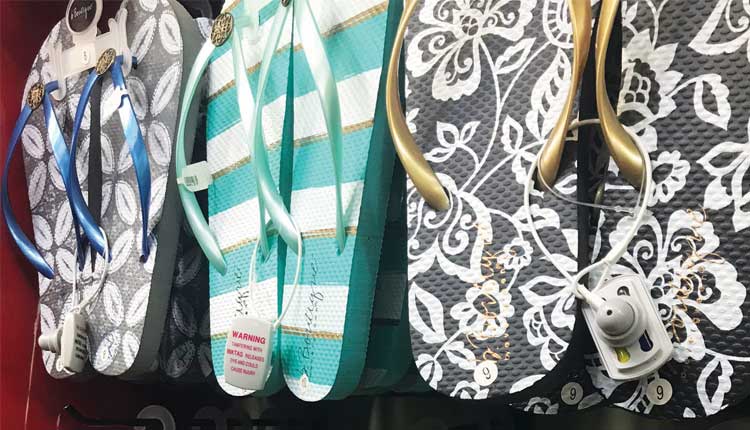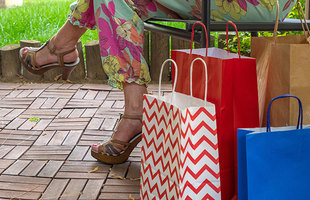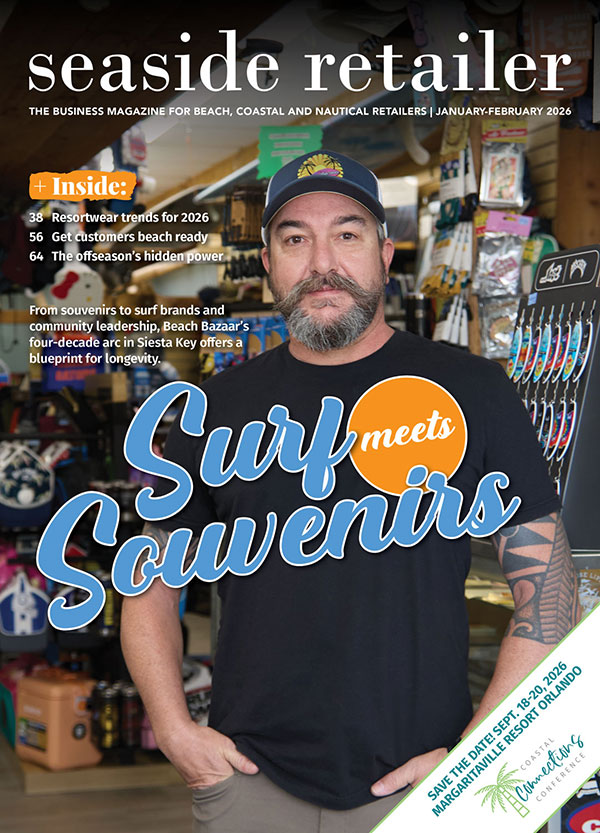Kandice Duffey, manager of Balboa Surf and Style, Newport Beach, California, recalls once when a group of high school boys came in. “I saw one boy rolling up shirts and stuffing them in his clothes, so I approached him and said, 'Do you want to give me what you have now or should I call the police?’” As his buddies snickered, he surrendered the shirts.
While this story is amusing, retail theft is no joke to a seaside retailer with an already-narrow profit margin. A large corporate chain can easily absorb losses due to petty pilferage, but a small retailer feels the pain much more acutely. Seaside stores employ many strategies to deter would-be thieves. Many stores along the shore use anti-theft devices on easy-to-conceal items, while others use signage that tugs at the conscience or rely on the eyes of staff and cameras. Here are some examples of successful theft-prevention tactics.
“Kill them with kindness”
Merely saying a cheery “Hello, welcome to our store!” may be the best theft deterrent of all. “The last thing a thief wants is to be recognized,” says retail consultant and educator Cathy Donovan Wagner, founder of
Chicago-based RETAILMavens.
Maria Martinez, manager of The Beach Nut, Virginia Beach, Virginia, knows this firsthand. “The biggest theft-prevention thing we do is make sure we’re walking the floor and welcoming our customers,” she says. “We’re a small store, but we have a lot of things that are just kind of laying around, display-wise. And as we’re welcoming people, we’re also subtly letting them know ‘we see you, we see what’s in our store’ — not just doing our own thing, ignoring them.”
Jared Gaburo owns two stores next door to each other in Sea Isle City, New Jersey — the Seaside Shade Shack, which specializes in sunglasses, and Tortuga, a store with higher-end beach apparel for men. “I’m pretty good about being on the floor and walking around,” says Gaburo, “especially when young kids are in the stores because they tend to be the ones that steal the most. It’s typically teenage girls who are the biggest offenders, trying to get their hands on the bracelets and anklets.”
Did you know? According to the National Association for Shoplifting Prevention, shoplifting costs the retail industry around $50 billion a year.
If a greeting doesn’t chase away a potential thief, try engaging them in conversation. “When these girls came in, I had a gut feeling they were going to steal,” says Duffey, “so I told an employee to be nice to them — 'kill them with kindness.’ As soon as we did that, they left.”
Candid cameras
Besides acting as a deterrent, security cameras are invaluable for gathering information for the police to follow up on.
The Beach Nut is inside a restaurant, Waterman’s Seaside Grill, that has cameras trained on the parking lot and valet stand. “If it’s someone who drove to the restaurant, we can easily pull the footage of the license plates to send to the police,” says Martinez. “We can also get names off the dinner checks from the restaurant’s point-of-sale system.”
Inside the store, there are more cameras angled at every corner. “If we need to watch someone more closely, we can do it from the monitor at the register or from my phone,” Martinez says.
Warning signs
In-store security cameras can do more than simply record thefts, they can deter them as well — as long as you let potential thieves know that they’re there. “You don’t actually have to have the cameras,” says Wagner. “Merely announcing that you have cameras will make a lot of potential thieves think twice.”
You can even add a dash of humor, as Duffey has. “As soon as you walk into our store, you’ll see a sign on the window saying, “Just to let you know, this place is covered in cameras. So please don’t steal, because if you do, I will call the police, and they’ll call your Mom,’ with a little sad-face emoji.”
Behind closed doors
Some seaside retailers choose to keep high-dollar merchandise in protective custody inside locked showcases. “All of our premium, luxury-brand sunglasses are inside locked cases,” says Gaburo. Valuable jewelry is kept at the register.
There are anti-theft systems like magnetic security tags, but those might be too pricey for a small retailer.
If you’ve ever been to an Apple store, you’ve probably noticed the steel cables anchoring the phones and computers. Duffy came up with a budget version of this. “We had these keychains that were getting stolen all the time, so I tied fishing line to them. It’s not like people can't yank the line and just take them, but it’d be a bit more noticeable.”
Keeping count
Shoplifters often take advantage of the privacy afforded by a dressing room curtain or door.
“We count the items when people go in and when they come out,” says Duffey. “I do it with them — ‘okay, you’ve got one, two, three, four items,’ — verbalizing that ‘I know you have four items, so you’d better come out with four items.’” Duffey and her co-workers also clear away clothing left hanging so there’s no confusion later.
But keeping count can be a challenge, admits Duffey. “When we’re busy, things can fall through the cracks, like people using the dressing room without asking.”
Martinez uses the counting technique too. “With the items that don’t sell as often we all keep mental counts in our head of how many there are. If we see an empty space, we’re really good about asking each other, ‘Did you sell that? It’s gone.’”
What to do and not to do
Emotions can run high when you see someone stealing, as the following story illustrates. “A guy came in here and walked around with one of our skateboards for a while, then set it down by the door and left,” remembers Duffey. “Before I got a chance to put it back, he returned, reached inside the door, grabbed the skateboard and left.”
What happened next Duffey admits shouldn’t have. “I hurtled over the counter and me and my co-worker just took off after him,” she says. They caught him and recovered the skateboard.
What should a shop owner or employee do when they observe someone shoplifting? Wagner asked a theft-prevention officer this question. “He said, ‘The first rule is, don’t confront them.’ The person committing the crime could be trying to get money to buy drugs and may not be in their right mind. They may get violent. It’s just too dangerous.’” No item of merchandise, no matter how valuable, is worth someone getting injured or even killed.
What should you do instead? “Make a mental note of what they’re wearing,” says Wagner, “anything that could identify the person. Get a license plate if possible. Then call the police.”
You don’t have to sit back and be a victim while unscrupulous individuals cut into your hard-earned profits. By taking a few precautions, you can make your store more appealing to shoppers and less appealing to shoplifters.




